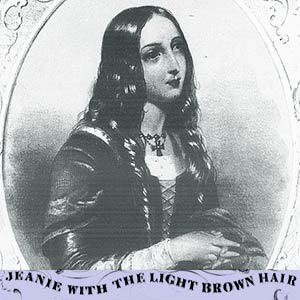
Jeanie with the light brown hair
by Stephen C. Foster.
|
|
||||
|
COMPOSERS OF POPULAR SONG |
|
||
Most of the music for solo voice in this collection consists of popular songs, whether for stage or for parlor. The major figures in this field during the 1820-60 time period were Stephen Foster and George Frederick Root, who also published under the name Wurzel ("Wurzel" is the German for root). Another extremely

Jeanie with the light brown hair by Stephen C. Foster. |
Some American composers of the period wished both to add to the repertoire of songs for the
concert hall and to compete with Schubert, Beethoven, Mendelssohn, and Bellini. The
boundaries between parlor song and "art song," as songs for formal concert settings were called,
were not as clear during the first half of the nineteenth century as they later became. Some of
Stephen Foster's songs seem appropriate for the concert hall, most notably
the Shakespearean duet
"Wilt Thou be Gone, Love."
American composers who
aspired to produce the art song in this period also included William Henry Fry,
George Frederick Bristow,
Richard Storrs Willis,
Anthony Philip Heinrich,
James M. Deems,
George F. Benkert,
George J. Webb,
Charles E. Horn,
William R. Bristow,
J. P. Knight,
George Loder,
Elam Ives,
Charles Jarvis, and
William Dempster.